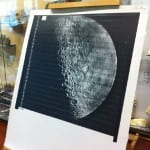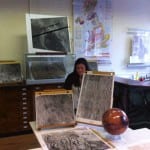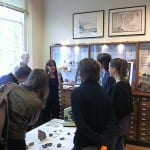Impact! – A Pop-up Exhibition
By Nick J Booth, on 21 March 2013
On Friday 1st March the UCL Geology Collections hosted a special Pop-up exhibition, called Impact!, curated by two PhD studnets from the Centre for Planetery Sciences (CPS), a ‘virtual’ research centre that comprises of staff and research students from both UCL and Birkbeck.
The aim of the Pop-up was simple. We wanted to advertise the opening hours of the Rock Room (1-3pm every Friday); we wanted to advertise the existence of the Regional
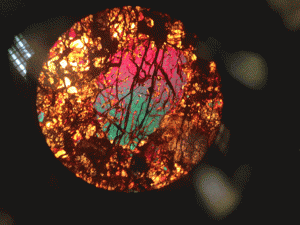
View of a Meteorite down a microscope
(Photo: Andrew Freeland)
Planetary Image Facility (RPIF) at UCL; and we wanted to showcase some of the amazing research carried out by PhD students at the CPS.
The process started when I emailed the data manager of the RPIF to see if he knew of any research students or staff who might be interested in putting on an event in the Rock Room. Luckily for us there were two who were. These were Amy Edgington, a UCL PhD student studying the interior of the planet Mercury, and Louise Alexander, a PhD student from Birkbeck, whose work focuses on Basaltic samples from the Apollo 12 landing site and what they can tell us about the magmatic evolution of the Moon.
The day of our first meeting coincided with the news of the Russian meteorite that fell over Chelyabinsk in Russia.As the RPIF houses an estimated 30,000 images of other planets and moons in our solar system, many of which show impact craters, the subject pretty much picked itself. As I’m sure you can appreciate, the name wasn’t too difficult to decide upon either.
Following this initial meeting Amy and Louise worked together to choose images from the thousands of prints from the RPIF. The archive includes images and other data from almost all of the NASA planetary missions since the 1960’s, covering all the planetary bodies in the solar system which have been surveyed to date by spacecraft, so I imagine it must have been difficult to pick just a few.
After deliberation they chose some pretty amazing images from some truly iconic missions. For the moon they chose a selection taken from the Lunar Orbiter Project (1966-7) and from the Apollo Missions (1963-1972). And for Mars images they chose images taken from the Viking Missions (1975 – 1980).
In addition to the 2D prints the exhibition was also able to feature meteorites from the UCL and Birkbeck Collections, and in fact during the event Louise manned a microscope showing thin sections taken from meteorites that allowed visitors a (very) rare opportunity to see what these space rocks are made of. As might be expected many visitors were interested to hear about the recent Russian meteorite, and we were able to show them examples of similar types of meteorite (which they could also handle).
As this was the first pop-up (or should we call it a ‘Rock-Up’? Geology jokes are always good) none of us were sure how successful the day would be. I had spent most of the week printing off and putting up posters advertising the event across campus, however as luck would have it it was the week of the student elections and so I was battling for space with about 100 aspiring politicians. Luckily my colleague Subhadra is a dab hand at poster 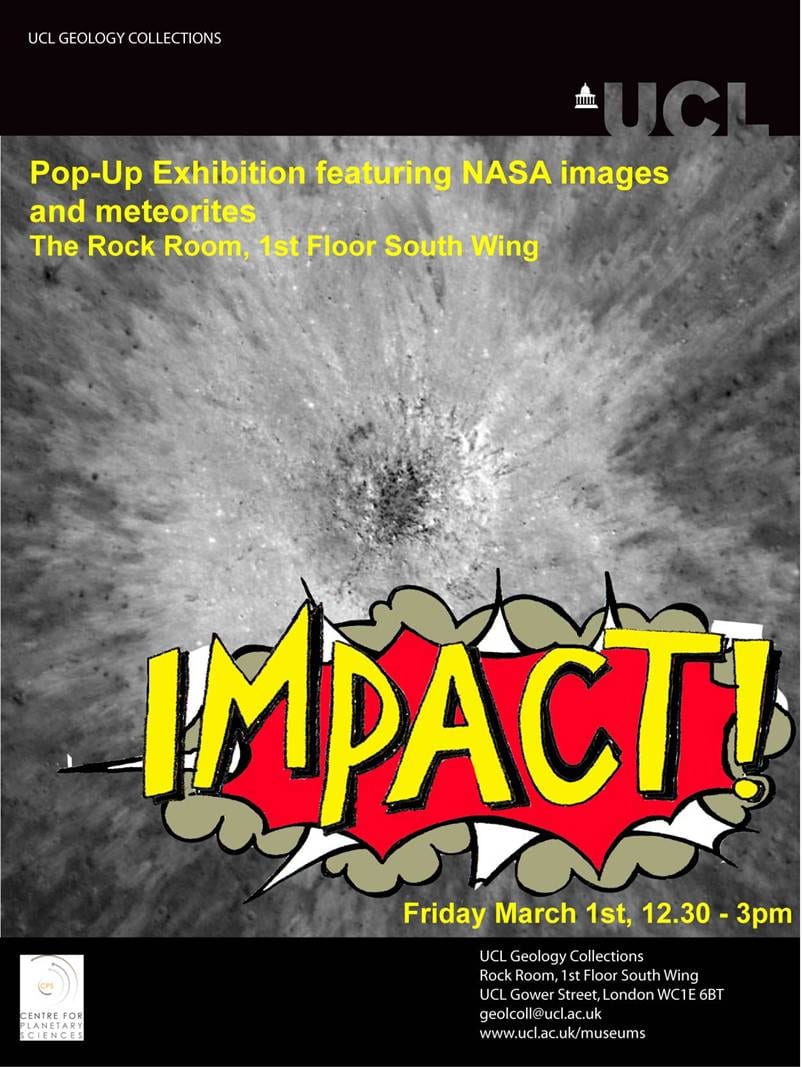 design and came up with a simple, yet effective and eye-catching design.
design and came up with a simple, yet effective and eye-catching design.
On the day of the event we began to set up at around 11.30, with the aim of ‘opening’ at 12.30. Colleagues at the Art Museum were good enough to lend us some of their easels for the event, which really helped the prints stand out.
As soon as we ‘officially’ opened we had our first visitor, a Birkbeck PhD student, who ended up staying in the space for over an hour and a half. And then people just kept arriving! In the 2.5 hours we were open we had almost 80 people visit, far exceeding my expectations.
Louise and Amy were fantastic, and I should take this opportunity to thank them again. From 12.30 until at least 3, and probably beyond that, they didn’t stop taking to visitors. And it really was none stop. During the event I did little more than make the tea, which more often than not went cold because they were so busy. But I did get a chance to talk to some visitors to find out where they were from, how they heard about us, etc. Most people had a connection to UCL, either as staff or post graduate students. However there were members of the general public present, who had seen the event advertised online. One lady I spoke to in particular had cancelled her days plans to come visit because ‘how often do you get an opportunity like this?’.
The idea of the Pop-up was that it should represent the minimum of preparation work for Louise and Amy. With this in mind we didn’t make up any labels. The day was about interaction between the curators and people who want to know about their work and the objects on display. This seemed to work well, and is a template that I expect we will use in the future. It is interesting to note that there were fewer undergraduates than we might have expected, and this is something that we could look to address in the future. It would also be interesting to see if we could attract more members of the general public, perhaps with more targeted advertising ahead of time.
However these are all minor points. Thanks to Amy and Louise the Rock Room’s first Pop-up was a major success and we will be hosting more in the future. Any suggestions please leave them below!
Amy Edgington’s PhD title is ‘The Study of the Composition, Internal Structure and Magnetic Field of Mercury’. Her supervisors are Prof Lidunka Vocadlo, Prof Lars Stixrude and Dr Ian Wood.
Louise Alexander’s PhD is in lunar geology – studying basalt fragments from the Apollo 12 site, searching for young exotic samples, and looking at what lunar basalts can tell us about the magmatic evolution of the Moon. Her supervisors are Prof Ian Crawford and Prof Hilary Downes.
 Close
Close


